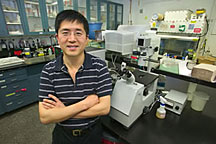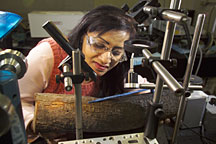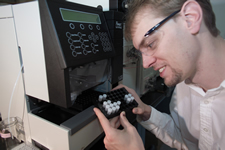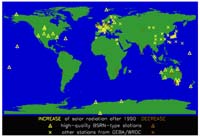| Research
|
Madhavi Martin is the first to admit she is a little out of place. Although she belongs to the Environmental Sciences Division at DOE's Oak Ridge National Laboratory, she is the division's only physicist by trade. Her role in that mostly organic organization actually speaks to the lab's increasingly interdisciplinary nature of research. "I'm trained in doing laser spectroscopy on semiconductors, but in ESD we have been using it for purposes such as detecting contaminants in environmental situations, for example, in soil and wastewater stream pollution," Martin says. "Now we're moving into forensics." In fact, Martin's work was recently featured in Analytical Chemistry magazine. Working with Henri Grissino-Mayer at the University of Tennessee, her laser-induced breakdown spectroscopy techniques helped tie a murder suspect to a critical piece of evidence. Martin, a native of India, received her doctorate at the University of California, Los Angeles. It was there that she met her husband, Rodger. "He was in nuclear engineering, and he got a job at the best place for that, which is ORNL," Martin says. After spending some time as a postdoc, she joined him at ORNL two years later. Martin is an advocate of furthering careers of women in science and recently participated in a poster session showcasing the research of more than 30 women scientists at ORNL representing a dozen divisions. Her hobbies include batik printing, an Indian craft that is similar to tie-dye. She and Rodger have two children. When at work, she spends her time applying her laser spectroscopy techniques to new uses. I'm kind of an oddball, using my expertise for different applications," she says. The odder the better, if that's the case. Submitted by DOE's Oak Ridge |
|||||||||||||||||||||||||||
|
Check out symmetry—the
|
Nano-Probes Allow an Inside
|
 |
|---|
| Fanqing Chen (pictured) and Daniele Gerion have harnessed the powers of nanotechnology to image the interior of cell nuclei.
|
Nanotechnology may be in its infancy, but biologists may soon use it to watch the inner workings of a living cell like never before. Scientists at DOE's Lawrence Berkeley National Laboratory (Berkeley Lab) and Lawrence Livermore National Laboratory have developed a way to sneak nano-sized probes inside cell nuclei where they can track life's fundamental processes, such as DNA repair, for hours on end.
“Our work represents the first time a biologist can image long-term phenomena within the nuclei of living cells,” says Fanqing Chen of Berkeley Lab's Life Sciences Division, who developed the technique with Daniele Gerion of Lawrence Livermore National Laboratory.
Their success lies in specially prepared crystalline semiconductors composed of a few hundred or thousand atoms that emit different colors of light when illuminated by a laser. Because these fluorescent probes are stable and nontoxic, they have the ability to remain in a cell's nucleus — without harming the cell or fading out — much longer than conventional fluorescent labels. This could give biologists a ringside seat to nuclear processes that span several hours or days, such as DNA replication, genomic alterations, and cell cycle control. The long-lived probes may also allow researchers to track the effectiveness of disease-fighting drugs that target these processes.
“We could determine whether a drug has arrived where it is supposed to, and if it is having the desired impact,” says Chen.
The first enduring look into the secret lives of cell nuclei comes by way of a strong collaboration between biologists and chemists. For the past four years, Chen and Gerion have worked closely with members of the lab of Paul Alivisatos, a Berkeley Lab chemist in the Materials Sciences Division and Associate Laboratory Director who helped pioneer the development of nano-sized crystals of semiconductor materials. Called quantum dots, these microscopic crystals have shown promise in such wide-ranging applications as solar cells, computer design, and biology. In 1998, for example, Alivisatos developed a way to fashion inorganic nanocrystals composed of cadmium selenide and cadmium sulfide into fluorescent probes suitable for the study of living cells. This technology has been licensed to the Hayward, California-based Quantum Dot Corporation for use in biological assays.
“We took the tool Paul developed and applied it to a problem faced by biologists every day — getting inside the nucleus, a desirable target because the cell's genetic information resides there,” says Chen. Submitted by DOE's
Lawrence Berkeley
National Laboratory



